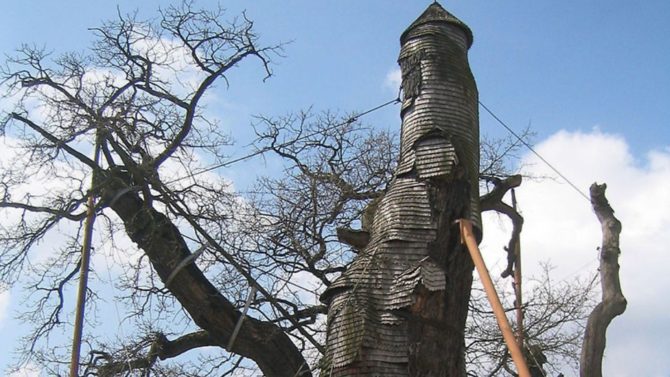Discover the fascinating story behind this unique chapel in a tree in Normandy

The Chêne Chapelle is one of Normandy’s most unique attractions

Madame Marie-José Mainot is neat and soigné, with grey hair swept up in a chignon, pearl earrings and sharp-framed cherry-red specs. She has taken the precaution of wearing a raincoat, as it is beginning to spit when she picks me up from the train station at Yvetot, a small town in the Caux region of Normandy.
“What I remember growing up here are fields – fields upon fields,” she murmurs, as we drive through them, passing a ‘clos-masure’ on the way. “That’s typical of the region,” she adds. A farm house and barns are surrounded by a double ring of beeches to make a windbreak against the gales that cross the low-lying meadows from the coast.
We are on our way to see an ancient oak of the genus Quercus robur – a so-called ‘remarkable tree’ – that has been awarded this appellation by the association A.R.B.R.E.S. founded in 1994 to protect such trees in France, recognising their significance to local history and the people who live near them.
Back to nature

I’d read about the famous centuries-old Chêne-Chapelle at Allouville-Bellefosse in Richard Mabey’s book The Cabaret of Plants, but nothing prepares me for the sight of this most extraordinary oak. I’d imagined it growing isolated in another field but no, I find it in the village where it seems to rear up out of the earth, its branches flung wide as if to embrace Saint Quentin church. It is without doubt the most outlandish leafy Grande Dame I’ve ever seen.
I walk round it while a couple of stooped pensioners tap past on walking sticks. The furrowed crevassed limbs of the oak are similarly supported by steel crutches and where the bark has fallen away the branches are sheathed in a protective armour of wood, shaped like roof tiles. The tree measures 16 metres in circumference at its base and 18 metres in height, with a crown of foliage studded with acorns that ripen and fall as they have for almost 1,200 years (a line-up of the oak’s ‘enfants’ are growing at the back of the church). A small turret with iron cross surmounts the main thrust of the trunk while a smaller one at a rakish tilt sits on an auxiliary branch. A wooden handrail and staircase helter-skelter upwards leading to two small chapels within the tree. Its hollowness is an indicator of great age, but it is these human interventions that make this oak particularly fascinating.
How much of the tree is actually tree?
All kinds of metaphors suggest themselves: an arboreal Frankenstein of separate body parts pieced together; the plant kingdom’s equivalent of a cyborg – half-tree, half man-made; a monument, even a theme park; a Paralympian champion, a survivor disabled by storms and lightning and the building of a new bell tower in 1769 that in all probability damaged one of its roots. It is dead inside yet fecund and youthful without. It’s almost shocking in its contrasts, in the same way as the sight of an industrial plant of smoking funnels and tubular pipes in the calm of a corn field on my way there.

The oak’s faux-rustic Disney sign indicates the dedication of the lower chapel to the Virgin Mary (Dame de la Paix) in 1696. At this time France, under King Louis XIV, was engaged in wars against foreign powers and the nearby ports of Dieppe and Le Havre lay in ruins. The villagers’ feared destruction was on its way and the curé encouraged them to pray for peace by dedicating the tree to the Virgin and slipping an image or statue inside its hollow trunk. At some point the crack became a chapel, which is how you will find it today, with a simple wooden altar, a polychrome statuette and vases of artificial flowers. Inside the diminutive chamber there’s room for perhaps two or three people. The second chapel, nicknamed the hermit’s chapel (Chambre de l’Ermite) was created a little later and is further up the staircase. Inside the cavity and fixed to the wall is a devotional wooden Christ, arms nailed to the cross, which turns the Son of God into a miniature tree. When I looked up, there was scaffolding inside to keep the trunk upright.
Revolution rumours
One story much repeated in books and magazines is that in 1793 when The Terror of the French Revolution was at its height and religious establishments were under threat, a band of revolutionaries assembled to burn down the Chêne-Chapelle. It was only saved by the village school master who put up a sign calling it ‘The Temple of Reason’ which convinced the brigands to leave it alone. Madame Mainot is doubtful of the truth of this tale. “It was not written down anywhere at the time – rien, rien du tout!” she exclaims emphatically.
Legends and anecdotes about the oak abound and it’s difficult to untangle what is true and what is not – perhaps it scarcely matters. “I’m not against legends,” Madame Mainot explains, “as long as they’re rational, but some are younger than I and are simply fictions”. Many stories have become exaggerated over time.
What’s the story behind ‘Remarkable Trees’?
To gain the status of a ‘Remarkable Tree’ the subject must meet at least one in a list of criteria. Advanced age is a category, but with qualifying conditions (a yew of 500 years is not exceptional, but a beech of 500 years would be). Physical characteristics of extreme height or circumference, historical importance (such as association with an historical event or person), aesthetic particularities (such as a tree in the shape of an animal) or botanical peculiarities (such as developing physical adaptations to its environment) and there’s even a ‘wild card’ category for trees that are distinguished for something else (such as growing in an area where they are not normally found).
Most of us have a memory of a tree that was special to us at a certain time in life. Mine belong to my teenage years when every weekend I’d climb a hill and sit beneath a row of three trees and look down to fields and farmland. From this vantage point, it really felt that the world was mine. When I went back a few years ago I found those trees no longer existed. In this sense, all trees are special, they make up the landscape of our inner selves and not just us, but the people who went before us and the generations ahead, so long live the remarkable trees of France!
How do I get there?
To visit the Chêne-Chapelle, take the train direct from Le Havre to Yvetot, which takes around 30 minutes. If travelling from Paris, the journey will take about 1hr 40min. After arriving in Yvetot, take a taxi onward to Allouville-Bellefosse.
Liked this? You might also like…
Share to: Facebook Twitter LinkedIn Email
More in Normandy


